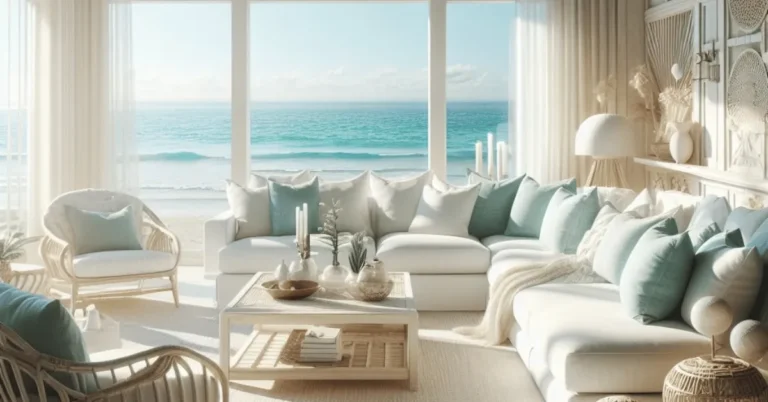So, you’ve heard the term “coastal style furniture” thrown around, but what does it really mean? Is it just a fancy way of saying “beachy”? Well, not exactly. Coastal style furniture is more than just a nod to the seaside; it’s a whole vibe, a way of life, if you will.
Picture yourself lounging in a beachfront villa, sipping a piña colada, and listening to the soothing sound of crashing waves.
That’s the essence of coastal style furniture. It’s all about creating a relaxed, breezy atmosphere that brings the beach to your home.
Let’s learn more about coastal style furniture, shall we?
What is coastal style furniture?
If you’re looking for a way to bring some breezy vibes into your home, you might want to consider coastal style furniture.
This type of furniture is inspired by the colors, textures, and materials of the seaside, and it can create a relaxing and inviting atmosphere in any room.
Coastal style furniture typically features lighter tones of blue, green, beige, and white, as well as natural elements like sisal rugs, sea glass accents, and linen fabrics.
You can also find coastal style furniture with casual and cozy designs, such as slipcovered sofas, wicker chairs, and rustic dining tables.
Coastal style furniture is perfect for anyone who loves the beach or just wants to add some charm and whimsy to their home. Just don’t forget to apply some sunscreen before you sit down!

What are the characteristics of coastal furniture?
Coastal furniture is a style of home décor that evokes the breezy and relaxed vibe of living by the sea. It typically features light colors, natural materials, and nautical motifs. Some of the characteristics of coastal furniture are:
Coastal furniture is a great way to create a soothing and inviting atmosphere in your home. Whether you live by the beach or not, you can enjoy the benefits of this style with some simple tips and tricks.
Read More: How to Decorate a Living Room in Coastal Style? (Full Guide)
What are coastal textures for furniture?
Coastal textures for furniture are a way of bringing the beach vibe into your home. They are inspired by the natural elements of the sea, such as sand, shells, driftwood, coral, and seaweed.
Coastal textures can create a relaxing and refreshing atmosphere in any room, especially if you pair them with light colors and nautical accessories. Some examples of coastal textures for furniture are:
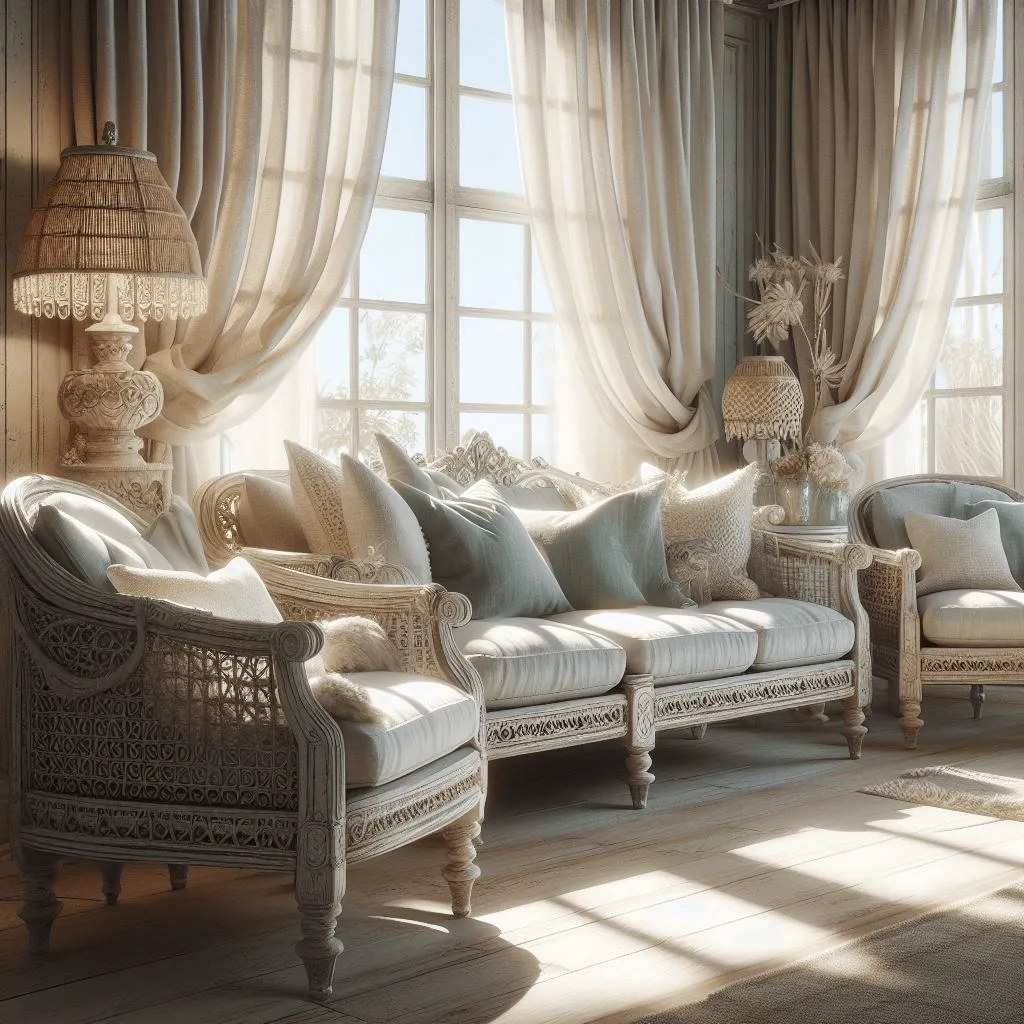
What is the difference between coastal and nautical style furniture?
Selecting the appropriate furniture plays a pivotal role in enhancing the aesthetics of your home. If you’re aiming for a beachy, relaxed vibe, you might be considering coastal or nautical style furniture. But what exactly sets these two styles apart? Let’s dive in and find out!
Coastal Style Furniture
Coastal style furniture is all about capturing the essence of the seaside. Think light and airy spaces with a touch of rustic charm.
This style often incorporates natural materials like wicker, rattan, and reclaimed wood. Soft pastel colors and ocean-inspired patterns are also common.
Coastal furniture tends to have a more casual and laid-back feel, perfect for creating a relaxed coastal retreat in your home.
Nautical Style Furniture
Nautical style furniture, on the other hand, takes its inspiration from the world of sailing. It embraces a more classic and refined aesthetic.
You’ll often find rich, dark woods like mahogany and oak, paired with navy blue and white color schemes.
Nautical furniture features clean lines and symmetrical designs, reminiscent of ship cabins and captain’s quarters.
This style is perfect for those who want to add a touch of sophistication and elegance to their space.

Read More: What is Modern Coastal Style? (How to Incorporate it?)
While both coastal and nautical style furniture share a common love for the sea, they differ in their overall vibe and design elements.
Coastal style furniture leans towards a more relaxed and casual look, while nautical style furniture exudes a timeless elegance.
Here we have the table of comparison as well.
| Feature | Coastal | Nautical |
|---|---|---|
| Inspiration | Beaches, dunes, coastal towns | Maritime elements, ships, sailing |
| Color Palette | Light and airy; white, beige, sand, blues | Navy blue and white stripes; red, gold, green |
| Materials | Natural materials (wood, wicker, rattan, jute, sisal, linen) | Natural and industrial materials (wood, rope, metal, brass, leather) |
| Design Features | Relaxed, casual, simple lines, minimal ornamentation | Structured, clean lines, nautical motifs, patterns and stripes |
| Decorative Accents | Seashells, coral, driftwood, natural textures | Nautical flags, anchors, maps, nautical paintings |
| Overall Feel | Relaxed, calming, serene | Crisp, adventurous, vibrant |
So, whether you’re dreaming of sipping piña coladas on a sandy beach or channeling your inner sailor, there’s a style of furniture to suit your taste.
Just remember to choose pieces that reflect your personality and create a space that makes you feel like you’re always on vacation!
What are the specific types of coastal furniture?
When it comes to furnishing your coastal abode, there are a plethora of options that capture the essence of seaside living. From nautical necessities to beachy beauties, let’s dive into the specific types of coastal furniture that will transform your home into a coastal retreat.
1. Adirondack Chairs
No coastal oasis is complete without a couple of Adirondack chairs. These iconic, slatted chairs are perfect for lounging on your porch or patio, sipping a refreshing drink, and enjoying the ocean breeze.
2. Rope Hammocks
For the ultimate relaxation, a rope hammock is a must-have. Imagine swaying gently in the breeze, listening to the sound of crashing waves, and feeling the sun kiss your skin. It’s pure bliss!
3. Wicker Furniture
Opting for wicker furniture remains a timeless and traditional selection for residences along the coast. Its natural and lightweight design adds a touch of rustic charm to any space. From wicker sofas and chairs to coffee tables and storage baskets, the options are endless.
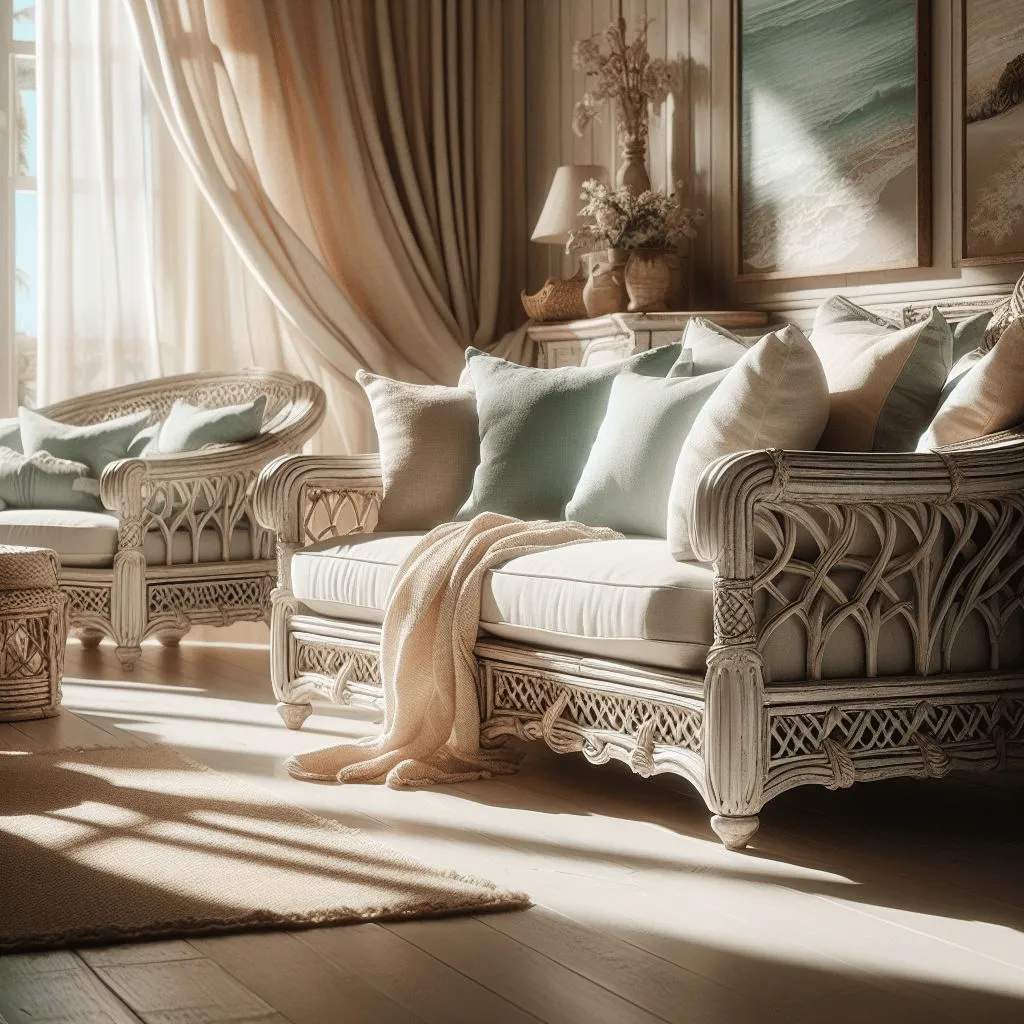
4. Driftwood Accents
Bring a touch of nature indoors with driftwood accents. From coffee tables and mirrors to lamps and wall art, these unique pieces add a coastal vibe and a hint of whimsy to your home.
5. Seashell Decor
No coastal theme is complete without seashell decor. Display your collection of seashells in glass jars or create stunning centerpieces using seashells and candles. It’s a simple yet effective way to bring the beach indoors.
So, whether you’re looking for a relaxing spot to unwind or want to infuse your home with coastal charm, these specific types of coastal furniture are sure to make a splash. Dive in and create your own coastal paradise!
Read More: Does Home Decor Include Furniture? (How to Choose It?)
How to place coastal furniture in your home?
Creating a cohesive and inviting coastal-themed space requires careful consideration of furniture placement. Here are some tips to help you achieve that relaxed beach vibe:
1. Utilize Negative Space:
Coastal style thrives on a sense of openness and airiness. Avoid clutter and allow ample space for furniture pieces to breathe. Consider the flow of traffic and ensure furniture placement doesn’t impede movement within the room.
2. Grouping Furniture:
Arrange furniture pieces in conversation groups to encourage interaction and foster a cozy atmosphere. Use a rug to anchor the grouping and define the space. Place armchairs and sofas at angles to create a more dynamic and interesting layout.
3. Layer Textures and Materials:
Combine natural textures like wicker, rattan, jute, and linen with smooth surfaces like wood and glass to create a visually interesting space. Add depth and dimension with throws, pillows, and rugs made from various materials.
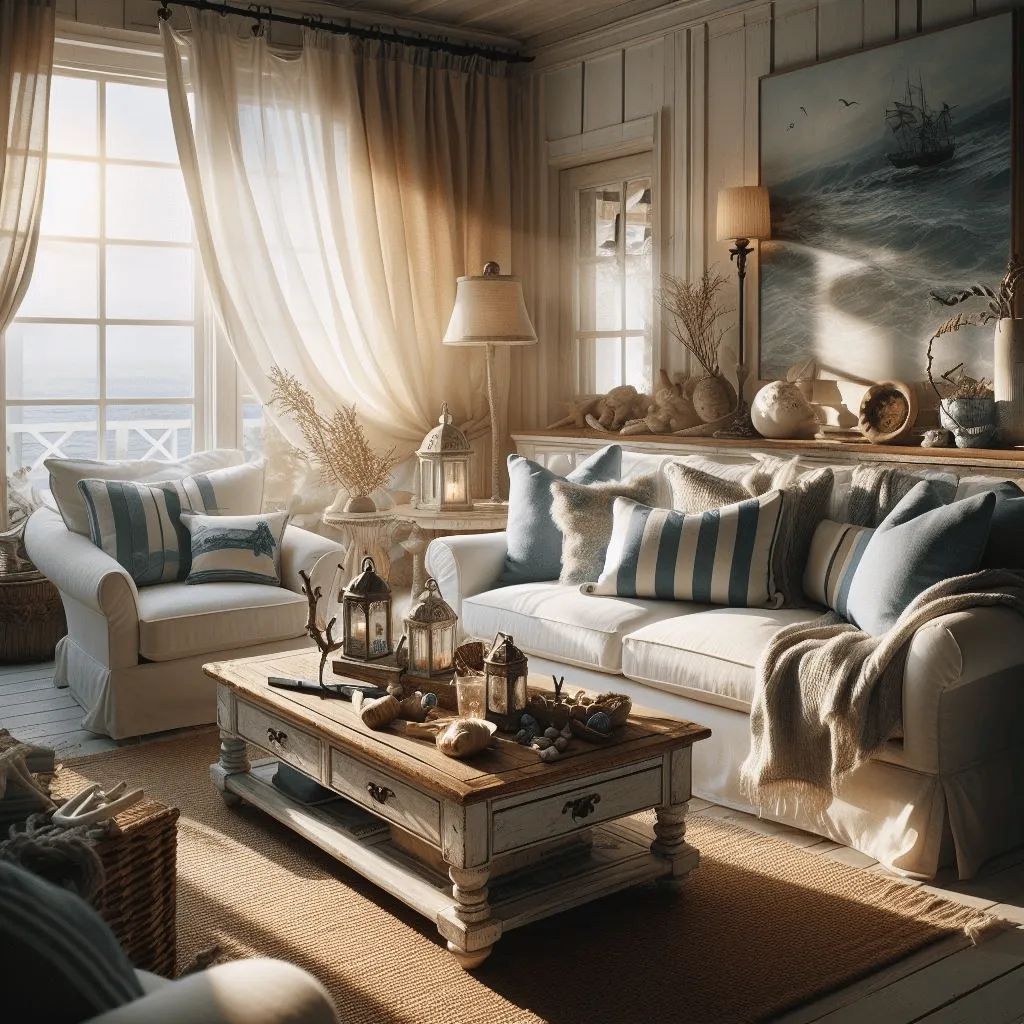
4. Maximize Natural Light:
Coastal style embraces natural light. Arrange furniture to take advantage of windows and doorways.
Use light-colored furniture and sheer curtains to maximize the feeling of openness and airiness. Consider incorporating mirrors to reflect light and create the illusion of a larger space.
5. Focus on Functionality:
Select furniture that seamlessly combines style with functionality. Consider using ottomans with storage, benches with built-in shelves, and nesting tables to maximize space and practicality.
Ensure furniture sizes are appropriate for the room to avoid overcrowding and maintain comfortable movement.
6. Embrace the Coastal Palette:
Opt for light and airy colors like whites, beiges, and blues to create a calming and serene atmosphere. Use pops of color like turquoise, coral, and yellow to add personality and interest.
Consider incorporating natural elements like seashells, coral, and driftwood to tie the color scheme to the coastal theme.
7. Accessorize Wisely:
Avoid overloading your space with an excess of decorative items. Choose accessories that complement the coastal theme, such as seascapes, nautical artwork, and woven baskets. Use fresh flowers and greenery to add a touch of life and natural beauty.
8. Don’t Be Afraid to Mix and Match:
Coastal style doesn’t require strict adherence to specific rules. Feel free to mix and match different styles and textures to create a unique and personal space.
Experiment with different furniture arrangements and find what works best for your space and preferences.
Read More: What Do You Choose First When Decorating?

What are the mistakes to avoid while selecting coastal style furniture?
Coastal style furniture is a great way to bring the breezy and relaxed vibe of the beach into your home.
However, not all coastal furniture is created equal, and there are some common mistakes that can ruin your seaside aesthetic.
Mistakes that you should avoid
Here are some of the pitfalls to avoid when choosing coastal style furniture:
Going overboard with nautical motifs. While a few anchors, shells, or starfish can add some charm to your coastal decor, too many of them can make your space look kitschy and cluttered.
Instead of filling every corner with nautical knick-knacks, opt for a more subtle approach and use them sparingly as accents.
Choosing the wrong colors. Coastal style furniture typically features light and airy colors, such as whites, creams, blues, and greens.
These hues evoke the feeling of sand, sky, and water, and create a soothing and harmonious atmosphere.
Avoid dark and heavy colors, such as browns, blacks, or reds, that can make your space feel cramped and gloomy.
Specific ones
Forgetting about texture. Texture is an important element of coastal style furniture, as it adds interest and depth to your space.
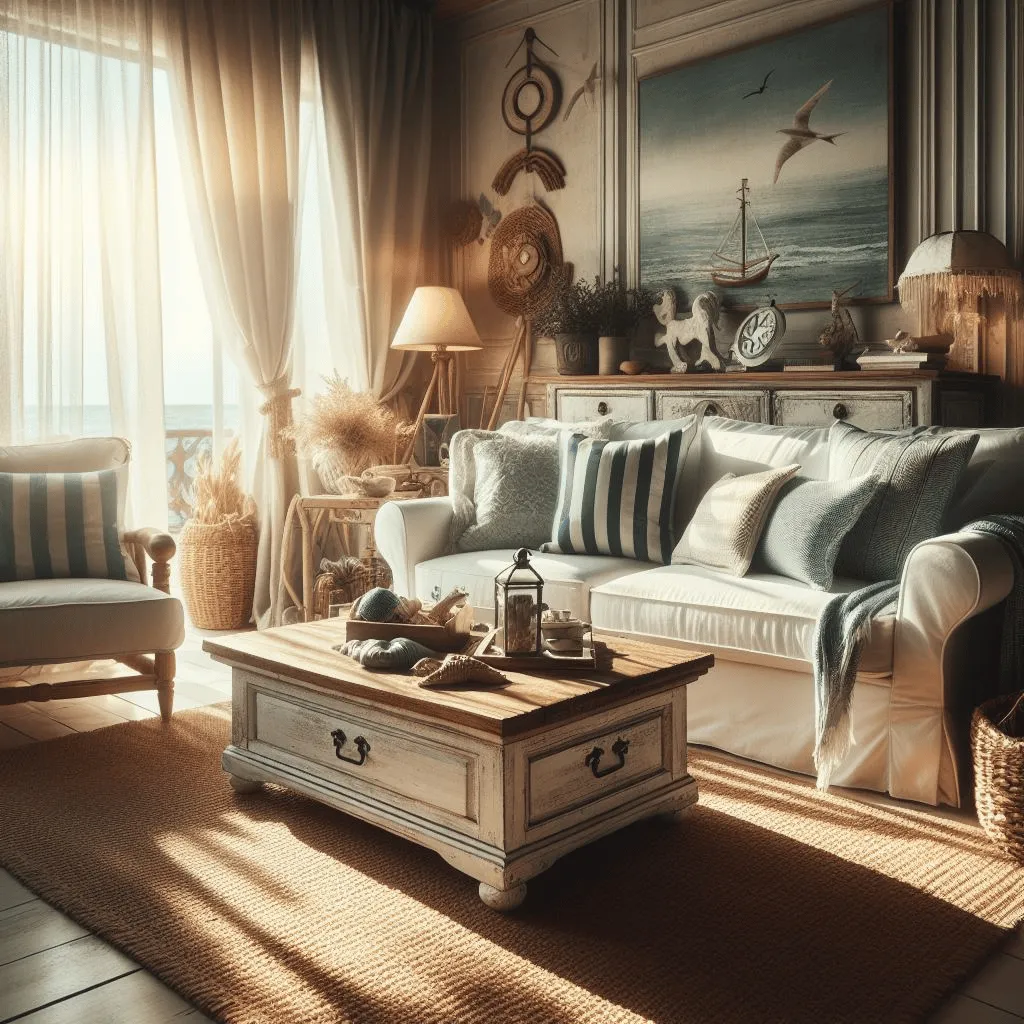
Look for furniture pieces that have natural materials, such as wood, rattan, wicker, or rope, that contrast with the smoothness of fabrics and metals.
Read More: What is Home Decor? (10 Home Decor Ideas)
You can also incorporate some soft and cozy textures, such as cotton, linen, or wool, that invite you to curl up and relax.
Ignoring the scale and proportion. Coastal style furniture should be comfortable and inviting, but not overwhelming or bulky.
Choose furniture pieces that fit the size and shape of your space, and leave enough room for movement and flow.
You don’t want your furniture to block the natural light or the view of the outdoors, which are essential for creating a coastal feel.
Neglecting the balance and harmony. Coastal style furniture should create a sense of balance and harmony in your space, not a clash of styles or colors.
You can mix and match different pieces of furniture, but make sure they have some common elements that tie them together.
For example, you can use a similar color palette, material, or theme for your furniture pieces, or add some accessories that unify them.
What are the benefits of having coastal style furniture in home?
Having coastal style furniture in your home offers a multitude of benefits, both aesthetic and psychological. Here are some key advantages:
Aesthetic Benefits:
Creates a Relaxing and Inviting Atmosphere: Coastal style evokes a sense of calm and serenity, reminiscent of tranquil beaches and breezy coastal living. Light colors, natural materials, and simple designs contribute to this calming effect.
Promotes Openness and Airiness: Coastal furniture typically emphasizes light and airy spaces, making rooms feel larger and more inviting. This is achieved through the use of light-colored furniture, open layouts, and minimal clutter.
Adds a Touch of Natural Beauty: Natural materials like wood, wicker, rattan, and jute are integral to coastal style. These elements bring the beauty of nature indoors, creating a sense of connection to the outdoors.
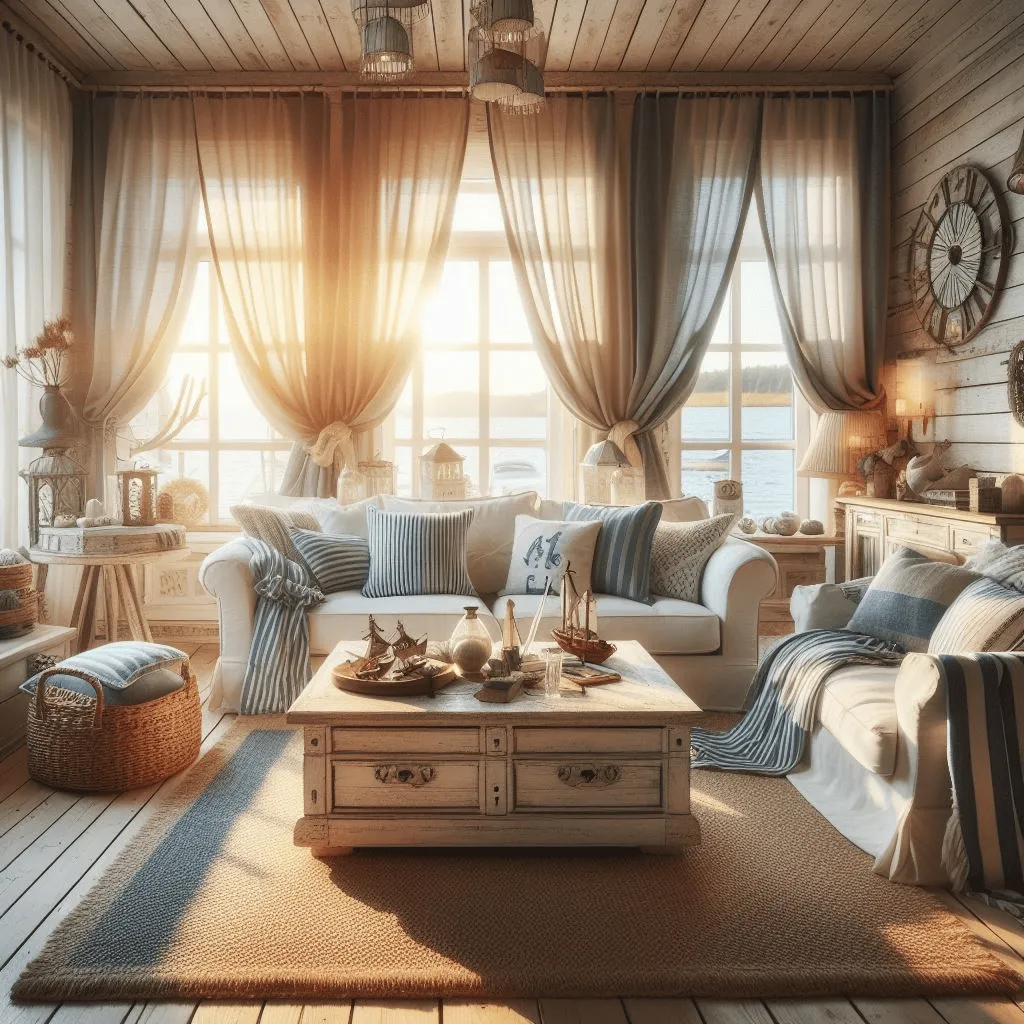
Offers a Timeless Appeal: Coastal style is classic and enduring. It never goes out of style and can be easily updated with new accessories and accents over time.
Psychological Benefits:
Reduces Stress and Anxiety: The calming and serene atmosphere created by coastal style can help reduce stress and anxiety levels, promoting relaxation and well-being.
Improves Mood and Emotional State: Spending time in a space that evokes positive emotions like peace and tranquility can lead to improved mood and overall emotional well-being.
Boosts Creativity and Imagination: The light and airy spaces associated with coastal style can stimulate creativity and imagination, making it a great choice for workspaces and creative endeavors.
Promotes Mindfulness and Connection to Nature: The natural elements and organic textures found in coastal furniture encourage a sense of mindfulness and connection to the natural world, which can be beneficial for mental health and well-being.
Additional Benefits:
Overall, having coastal style furniture in your home can create a beautiful, inviting, and relaxing space that is beneficial for both your physical and emotional well-being.
By incorporating natural materials, light colors, and simple designs, you can create a haven that promotes peace, tranquility, and a sense of connection to the natural world.
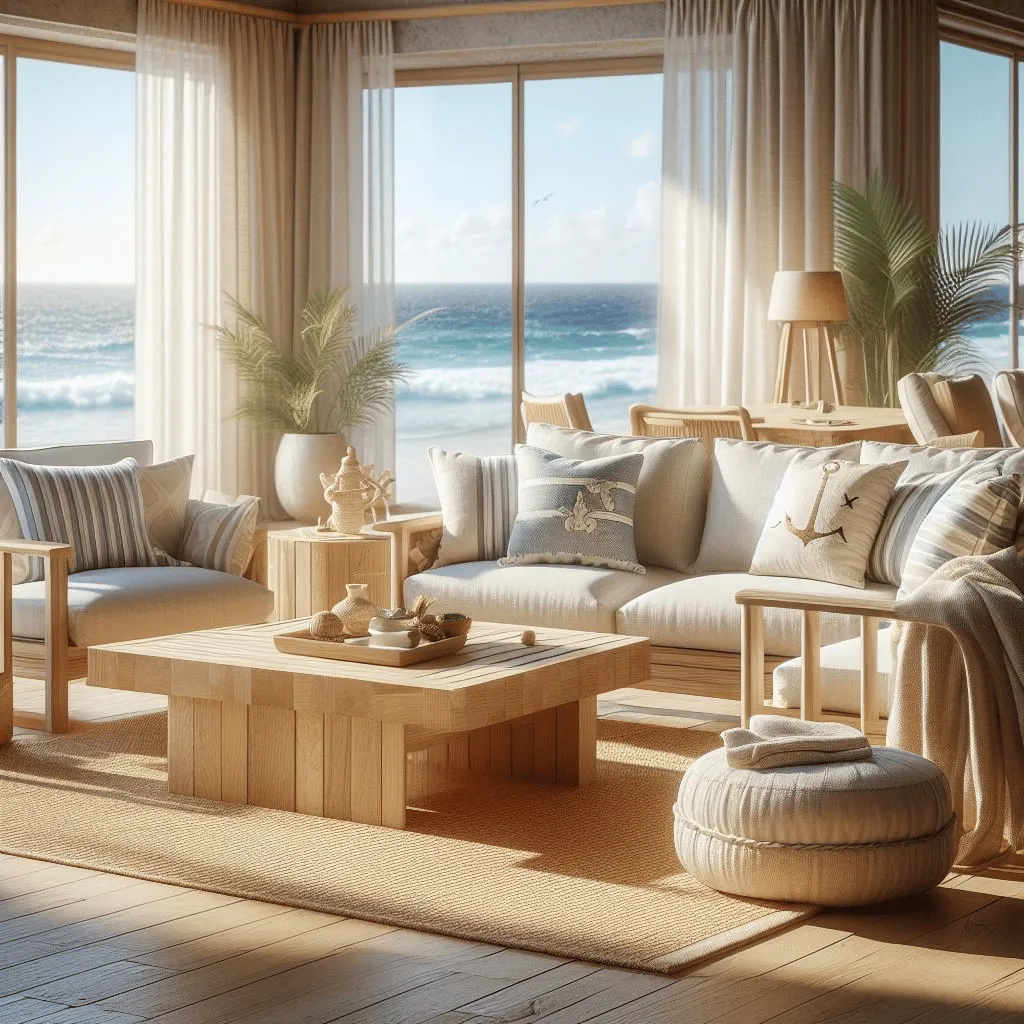
Final Thoughts – What is Coastal Style Furniture?
Coastal style furniture, oh how we adore thee! With its breezy charm and relaxed vibes, coastal style furniture is like a breath of fresh air for your home.
Whether you live by the beach or in the heart of the city, incorporating coastal elements into your interior design can transport you to a seaside paradise.
But what exactly is coastal style furniture? Well, it’s all about embracing the laid-back coastal lifestyle and bringing it indoors.
Think light and airy colors, natural textures, and a hint of nautical flair. It’s like having a permanent vacation in your own home.
When it comes to coastal style furniture, think of pieces that exude a sense of casual elegance.
Whitewashed finishes, weathered wood, and rattan accents are just a few examples of the materials commonly used in coastal design. These elements create a relaxed and inviting atmosphere that instantly puts you at ease.
So, whether you’re looking to revamp your entire home or just add a touch of coastal charm to a room, coastal style furniture is the way to go.
It’s a timeless and versatile design aesthetic that never goes out of style. So go ahead, bring a piece of the beach into your home and let the coastal vibes wash over you.
After all, as they say, life’s a beach, so why not make your home feel like one too?
FAQs
Coastal style furniture can be integrated into any location, not just coastal areas. Opt for light colors, natural materials, and beach-inspired accessories.
Consider using lighter tones of blue, green, beige, and white, and incorporate elements like wicker, rattan, and sea-themed accents to bring the coastal vibe to your home.
There are budget-friendly options for coastal furniture. Look for second-hand or thrifted pieces that can be refurbished with a fresh coat of paint.
Additionally, consider DIY projects like creating driftwood-inspired decor or transforming existing furniture with coastal colors to achieve the look without breaking the bank.
Yes, coastal furniture can be mixed with other design styles to create a personalized look. Blend coastal elements with modern, traditional, or eclectic styles by incorporating key coastal pieces like light-colored sofas or wicker chairs alongside furniture from other design aesthetics.
One common misconception is that coastal style is limited to beach-themed decor. In reality, coastal style is versatile and can encompass a range of influences beyond just nautical elements.
Another misconception is that it’s only suitable for homes near the coast; however, it can be adapted to various settings.
To care for coastal furniture, avoid exposure to harsh elements if used outdoors. Regularly clean and dust furniture to prevent salt or sand buildup.
For indoor pieces, protect against direct sunlight to prevent fading. For wicker or rattan, periodic cleaning with a damp cloth is recommended, and cushions should be stored during inclement weather if used outdoors.







